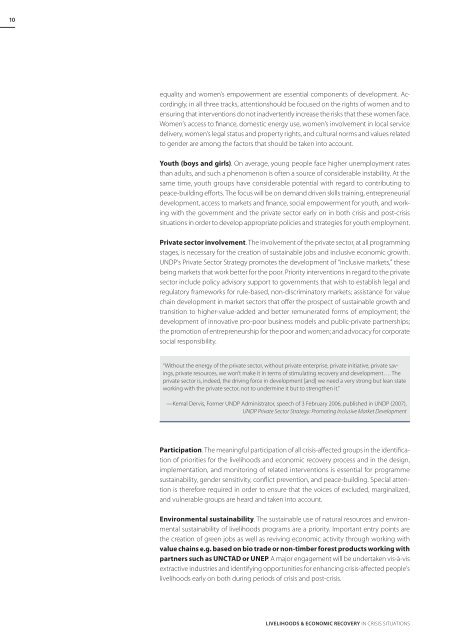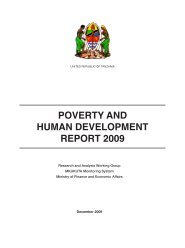Download PDF (4.08 MB) - ReliefWeb
Download PDF (4.08 MB) - ReliefWeb
Download PDF (4.08 MB) - ReliefWeb
Create successful ePaper yourself
Turn your PDF publications into a flip-book with our unique Google optimized e-Paper software.
10<br />
equality and women’s empowerment are essential components of development. Accordingly,<br />
in all three tracks, attentionshould be focused on the rights of women and to<br />
ensuring that interventions do not inadvertently increase the risks that these women face.<br />
Women’s access to finance, domestic energy use, women’s involvement in local service<br />
delivery, women’s legal status and property rights, and cultural norms and values related<br />
to gender are among the factors that should be taken into account.<br />
Youth (boys and girls). On average, young people face higher unemployment rates<br />
than adults, and such a phenomenon is often a source of considerable instability. At the<br />
same time, youth groups have considerable potential with regard to contributing to<br />
peace-building efforts. The focus will be on demand driven skills training, entrepreneurial<br />
development, access to markets and finance, social empowerment for youth, and working<br />
with the government and the private sector early on in both crisis and post-crisis<br />
situations in order to develop appropriate policies and strategies for youth employment.<br />
Private sector involvement. The involvement of the private sector, at all programming<br />
stages, is necessary for the creation of sustainable jobs and inclusive economic growth.<br />
UNDP’s Private Sector Strategy promotes the development of “inclusive markets,” these<br />
being markets that work better for the poor. Priority interventions in regard to the private<br />
sector include policy advisory support to governments that wish to establish legal and<br />
regulatory frameworks for rule-based, non-discriminatory markets; assistance for value<br />
chain development in market sectors that offer the prospect of sustainable growth and<br />
transition to higher-value-added and better remunerated forms of employment; the<br />
development of innovative pro-poor business models and public-private partnerships;<br />
the promotion of entrepreneurship for the poor and women; and advocacy for corporate<br />
social responsibility.<br />
“Without the energy of the private sector, without private enterprise, private initiative, private savings,<br />
private resources, we won’t make it in terms of stimulating recovery and development…. The<br />
private sector is, indeed, the driving force in development [and] we need a very strong but lean state<br />
working with the private sector, not to undermine it but to strengthen it.”<br />
—Kemal Dervis, Former UNDP Administrator, speech of 3 February 2006, published in UNDP (2007),<br />
UNDP Private Sector Strategy: Promoting Inclusive Market Development<br />
Participation. The meaningful participation of all crisis-affected groups in the identification<br />
of priorities for the livelihoods and economic recovery process and in the design,<br />
implementation, and monitoring of related interventions is essential for programme<br />
sustainability, gender sensitivity, conflict prevention, and peace-building. Special attention<br />
is therefore required in order to ensure that the voices of excluded, marginalized,<br />
and vulnerable groups are heard and taken into account.<br />
Environmental sustainability. The sustainable use of natural resources and environmental<br />
sustainability of livelihoods programs are a priority. Important entry points are<br />
the creation of green jobs as well as reviving economic activity through working with<br />
value chains e.g. based on bio trade or non-timber forest products working with<br />
partners such as UNCTAD or UNEP. A major engagement will be undertaken vis-à-vis<br />
extractive industries and identifying opportunities for enhancing crisis-affected people’s<br />
livelihoods early on both during periods of crisis and post-crisis.<br />
Livelihoods & Economic Recovery in Crisis Situations





